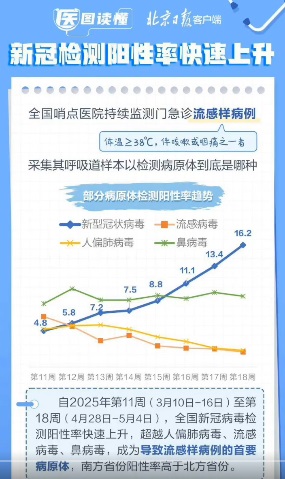COVID-19 Test Positivity Rate Hits 16.2 Percent in China as the NB.1.8.1 Variant and Its New Lineages Wreak Havoc
Nikhil Prasad Fact checked by:Thailand Medical News Team May 21, 2025 4 months, 2 weeks, 3 days, 9 hours, 43 minutes ago
Medical News: Hospitals fill up again as authorities downplay the crisis and fail to provide clear epidemic data
A concerning resurgence of COVID-19 is sweeping across China once again, with official test positivity rates hitting a worrying 16.2 percent. New data shows that this spike is largely driven by the NB.1.8.1 subvariant of Omicron and its offshoot lineages, which are now wreaking havoc across both northern and southern provinces. Health authorities reported that the rate of positive nucleic acid tests among patients with influenza-like illness in outpatient and emergency departments rose sharply from 7.5 percent to 16.2 percent. Among hospitalized patients with severe acute respiratory infections, COVID-19 positivity increased from 3.3 percent to 6.3 percent during the same period.
 COVID-19 Test Positivity Rate Hits 16.2 Percent in China as the NB.1.8.1 Variant and Its
COVID-19 Test Positivity Rate Hits 16.2 Percent in China as the NB.1.8.1 Variant and Its
New Lineages Wreak Havoc
Strikingly, southern regions are now experiencing even higher test positivity rates than northern areas. Regardless of geography, the novel coronavirus has reclaimed its position as the most dominant respiratory pathogen in flu-like illness cases, especially in individuals aged 15 and older. Yet despite this alarming trend, Chinese Communist Party officials have refused to release full-scale epidemic data. Instead, they have only disclosed partial figures regarding test positivity, sparking criticism and fueling suspicions that the situation is far worse than officially acknowledged.
This
Medical News report aims to shed light on the current crisis by consolidating expert opinions, firsthand reports, and statistical data. Videos circulating online suggest the situation is escalating rapidly, with Chinese hospitals once again overwhelmed by patient surges. Footage shows packed waiting rooms and corridors crowded with coughing and feverish individuals. On social media, people claim that numerous friends, relatives, and neighbors have either fallen ill or succumbed to COVID-19 in recent weeks. However, strict censorship and information control are preventing accurate reporting and public discourse.
 People Say COVID-19 Will Never End
People Say COVID-19 Will Never End
Public sentiment reflects growing frustration and fear. Many mainland Chinese residents are sharing accounts of worsening symptoms among their peers — including high fevers, chills, coughs, intense sore throat, hyperthermia, gastrointestinal issues, facial palsy, vision issues etc. A popular term gaining traction is “razor blade throat,” which refers to the severe pain experienced during swallowing, reportedly more intense with the NB.1.8.1 strain than previous waves. A growing number of citizens are taking personal precautions, such as masking up in public spaces, amid limited government transparency.
According to renowned Ch
inese respiratory specialist Dr Zhong Nanshan, this current wave of infections is expected to peak and decline by the end of June. He estimates that the wave, driven primarily by the NB.1.8.1 subvariant (a descendent of the highly mutated Omicron XDV lineage), will last approximately six to eight weeks. Dr Zhong emphasized that the situation, while serious, remains “preventable and controllable.” Still, he warned that elderly individuals over 65 and those with underlying medical conditions are at significantly higher risk of developing severe or life-threatening complications.
Despite its high transmission rate, Dr Zhong claimed that NB.1.8.1 ability to cause severe disease is relatively weak in younger, healthier individuals. Nevertheless, he underscored the importance of delivering antiviral treatments within 48 hours of symptom onset, especially to vulnerable populations, to prevent deterioration into serious illness.
Dr Zhong also highlighted the virus's long-term persistence, cautioning against the belief that COVID-19 will simply disappear or become a harmless seasonal flu. He reiterated that “COVID-19 is unlikely to ever completely go away,” and said it is still too early to conclude whether it will transition into a fully seasonal disease like influenza. He noted that infection rates in northern provinces began rising earlier and are already beginning to decline, while southern regions are just now approaching their peak.
Conclusion
China is now entering yet another difficult phase of the COVID-19 pandemic, exacerbated by the rapid spread of the NB.1.8.1 variant and a lack of transparent communication from authorities. While experts maintain that this wave can be managed with timely interventions, the surge in hospitalizations and increasing anecdotal reports of severe illness are painting a more troubling picture on the ground. As the virus continues to mutate and spread, particularly among vulnerable groups, it becomes ever more important to remain vigilant, informed, and prepared. There is no indication that COVID-19 is going away anytime soon, and this latest outbreak is a sobering reminder of how quickly things can spiral when proper public health responses are delayed or suppressed.
For the latest COVID-19 News, keep on logging to Thailand
Medical News.
Read Also:
https://www.thailandmedical.news/news/persistent-low-grade-hyperthermia-not-fever-emerging-as-one-of-the-symptoms-of-sars-cov-2-nb-1-8-1-infection
https://www.thailandmedical.news/news/covid-19-silently-ravaging-parts-of-myanmar-with-many-needing-proper-hospitalization-and-icu-care-desperately
https://www.thailandmedical.news/news/india-reports-257-new-covid-19-infections
https://www.thailandmedical.news/articles/coronavirus
https://www.thailandmedical.news/pages/thailand_doctors_listings

